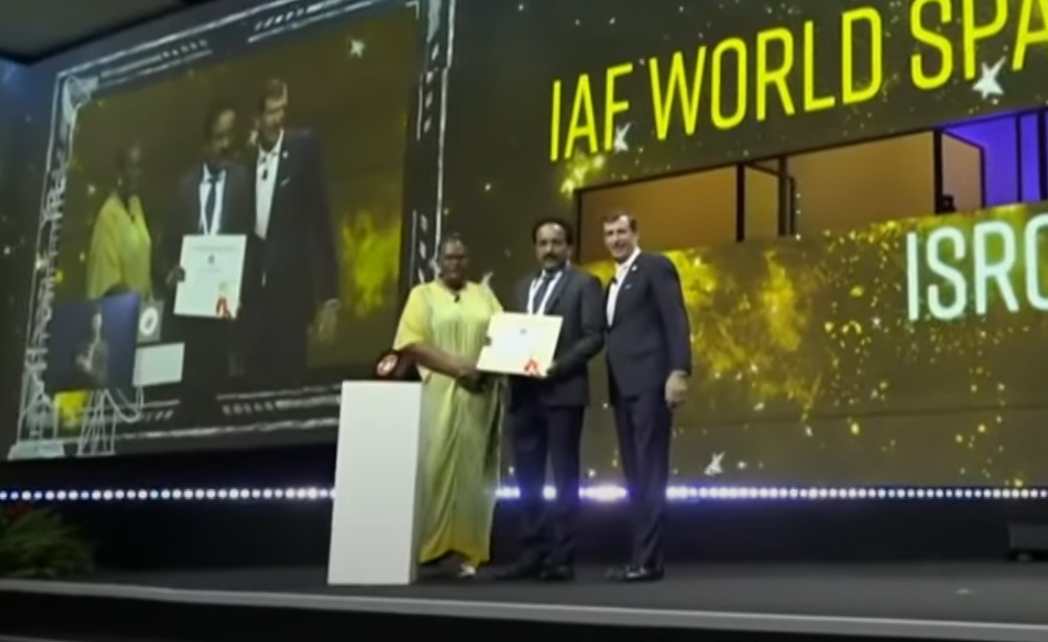ISRO Chandrayaan-3 Team received the prestigious International Astronautical Federation’s (IAF) World Space Award in a glittering ceremony at the 75th International Astronautical Congress held in Milan, Italy from 14-18 October 2024. This award is in recognition of India’s prowess in space technology that led to the successful soft landing of the Indian mission on the moon’s southern polar region on 23 August 2023. A remarkable achievement and a historic first watched live by millions across the world when India achieved this sensational feat. Earlier, the USA, Russia, and China landed around the moon’s equatorial region, but no country ever made a soft landing on the more challenging rough terrain of the south pole. Starting modestly in 1962 through sounding rockets, under the able guidance and leadership of Dr Vikram Sarabhai India has come of age rubbing shoulders with the space leader NASA and competing with other world space agencies.
Space research in the world is the outcome of rivalry between the USA and the former USSR, post-World War II. Tensions arose between these two countries somewhere around the 1950s when both emerged as superpowers and a race began to develop nuclear warheads that can be delivered across continents. This gave birth to the development of Intercontinental Ballistic Missiles (ICBMs) that needed to travel long distances and require a rocket that could be launched into outer space. This race led to the launching of artificial satellites into space in the later part of the 1950s when the USSR launched the world’s first satellite Sputnik-1 into space on 4 October 1957 into an elliptical low Earth orbit. It sent a radio signal back to Earth for three weeks before its three silver-zinc batteries got depleted. A month later, Sputnik 2 was launched with a living creature on board a satellite, for the first time. It was a dog named Laika, the first living creature to be launched into Earth’s orbit. The competition was so extreme that the USA followed with its first satellite, the Explorer-1 launched on 31 January 1958 marking the beginning of the U.S. Space Age. And as it is said, the rest is history.

Inspired by these developments, Dr. Vikram Sarabhai convinced Jawaharlal Nehru that India should have its space program leading to the establishment of INCOSPAR (Indian National Committee for Space Research) in 1962, later rechristened as ISRO (Indian Space Research Organisation) in 1969. Working on a shoestring budget, post-independence, and a period of technology denial from the USA and USSR as both would not sell their ultra-sensitive technology, they discovered, that India achieved its first indigenous success with the Satellite Launch Vehicle – SLV3 in 1980. Spearheaded by Dr. A P J Abdul Kalam, Rohini Satellite (RS-1) a 35 kg experimental spin-stabilized satellite was successfully launched on board SLV-3 from SHAR Centre on 18 July. Thanks to the efforts of Prof. U R Rao, indigenously built Aryabhata and Bhaskara satellites were earlier launched but on Russian vehicles. Later, cooperation with the USA and USSR resulted in the launching of several Indian National Satellite Systems (INSAT) for communication through radio waves that made television broadcasting and weather forecasting possible in India. Another noteworthy development of this cooperation was Rakesh Sharma, a former pilot of the Indian Air Force, becoming the first and only Indian citizen to travel to space on board Soyuz 11 in 1984 and remained in space for 8 days as part of the USSR Interkosmos Space Programme.
The beginning of the 21st century saw rapid progress in Indian space missions beginning with Chandrayan-1 in 2008 and finding signs of the presence of water in moon samples. India’s first Mars orbiter mission was a grand success in its first attempt in 2013. Every design and making in space technology was a discovery for Indian scientists. Though there were a few faltering steps, like the Chandrayaan-2 crash landing, ISRO marched ahead and several countries including the USA, Canada, Spain, and Australia also started relying on it for launching their satellites; the most striking of them was the record-breaking launch of 104 satellites in one go on a PSLV, the workhorse of our space missions with a success rate of 93%. The soft landing of Chandrayaan-3 has opened floodgates for ISRO for its future ambitious programs like Gaganyaan, man’s mission to the moon, an Indian space station, and Shukrayaan-1 mission to Venus shortly. The launch of Aditya L1 was yet another success for Indian space technology to study the Sun’s outer atmosphere.
ISRO is now a top space agency in the world and it is looked upon as a new entrant space superpower. But, one thing that separates ISRO from other space organizations is its cost-effective and unique technologies now and then. One example that is worth mentioning is the Mangalyaan mission that cost US$73 million or Rs.450 crores, approximately, that is one tenth of what the USA spent on MAVEN, NASA’s Mars Atmosphere and Volatile Evolution mission to understand how Mar’s atmosphere and climate have changed over time. To explain in common parlance, the cost of the Mangalyaan mission is approximately four times cheaper than the Bandra-Worli Sea Link, a 5.6-kilometre cable-stayed eight-lane bridge over open seas in Mumbai, Maharashtra. This made Prime Minister Narendra Modi quip after the success of Mar’s mission that, “A one-km auto rickshaw ride in Ahmedabad takes Rs 10 and India reached Mars at Rs 7 per km which is amazing.” Kudos to Indian Scientists, this is just the beginning.





